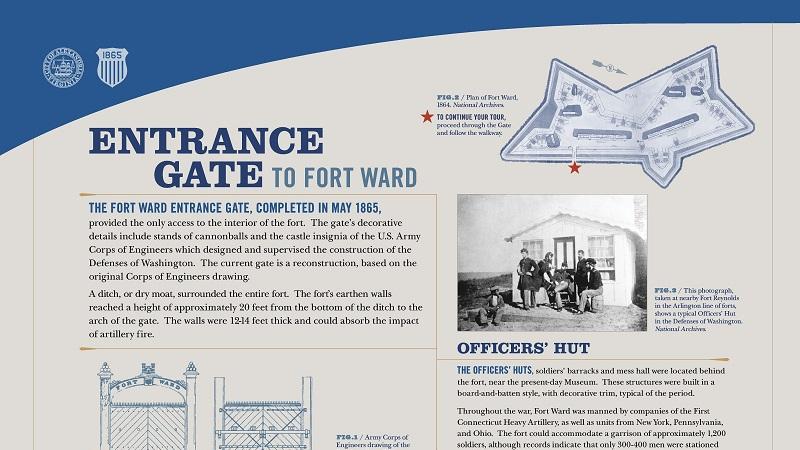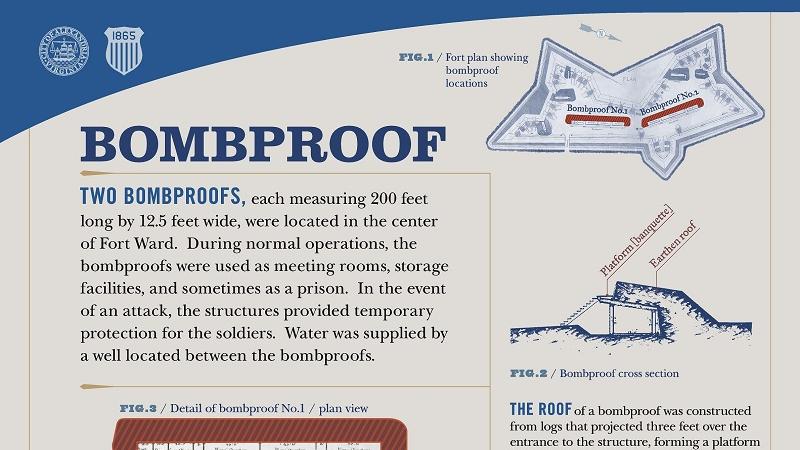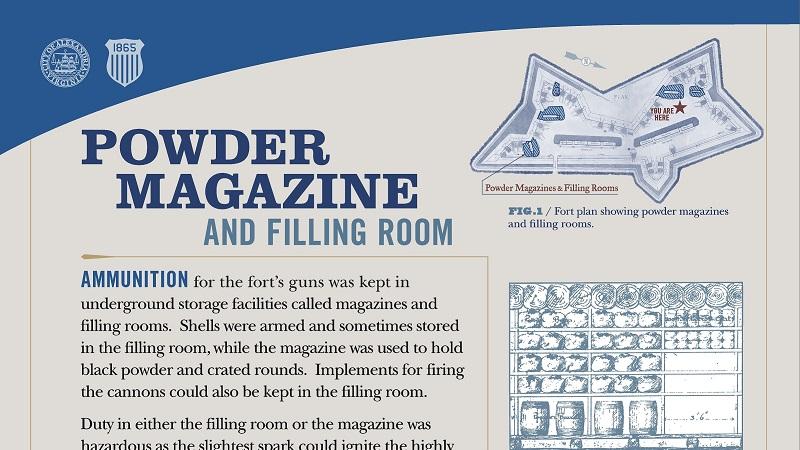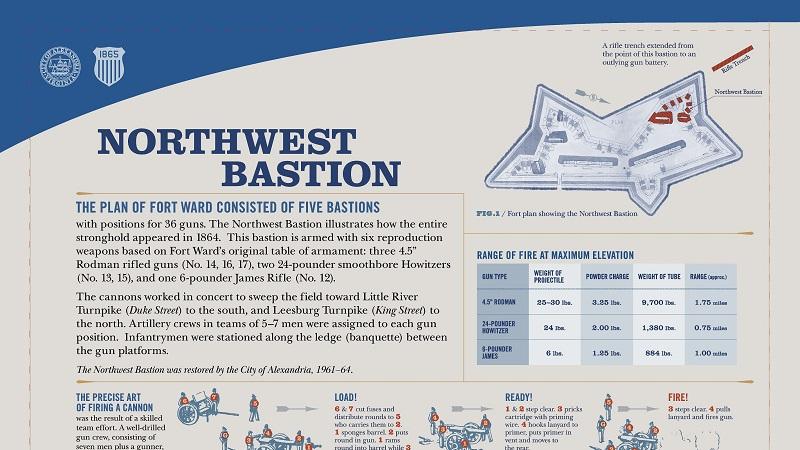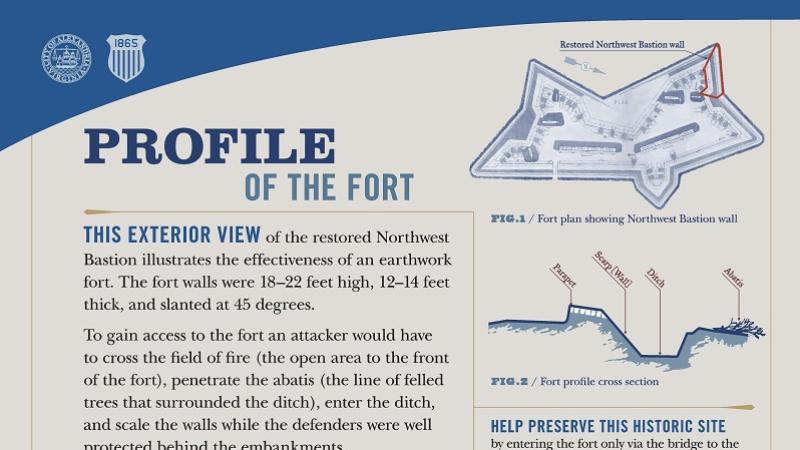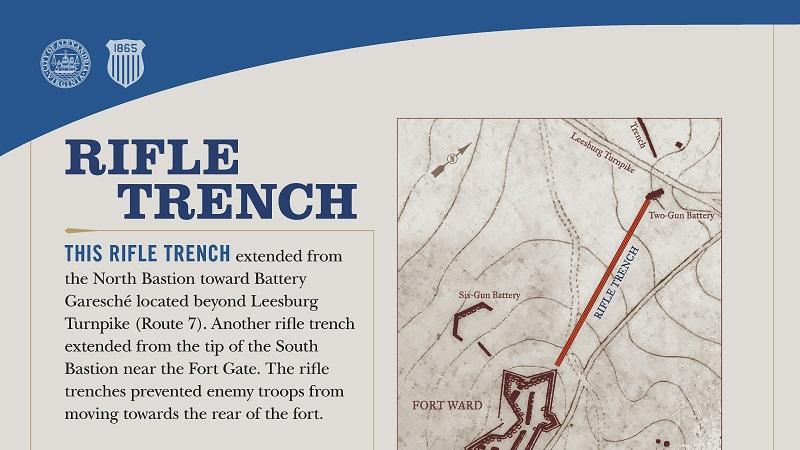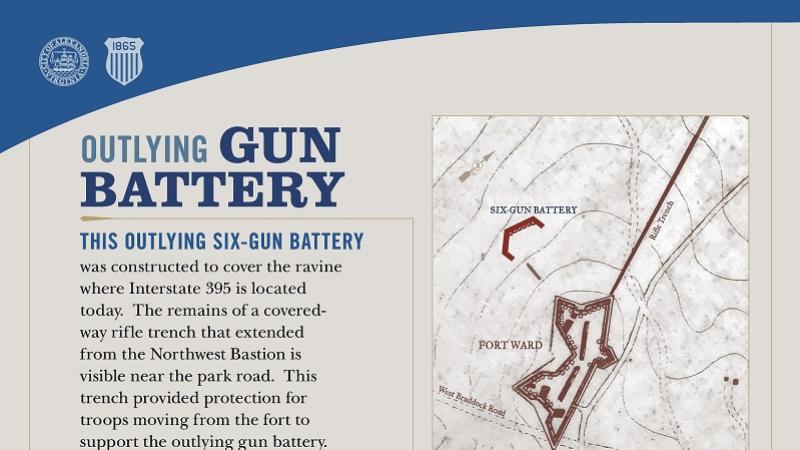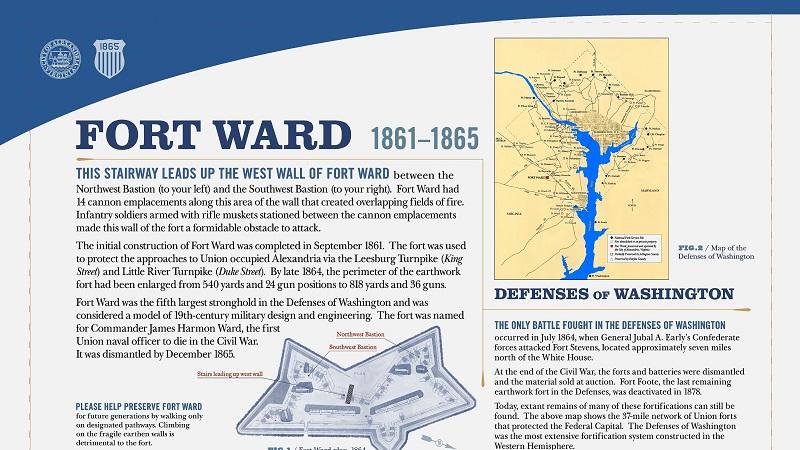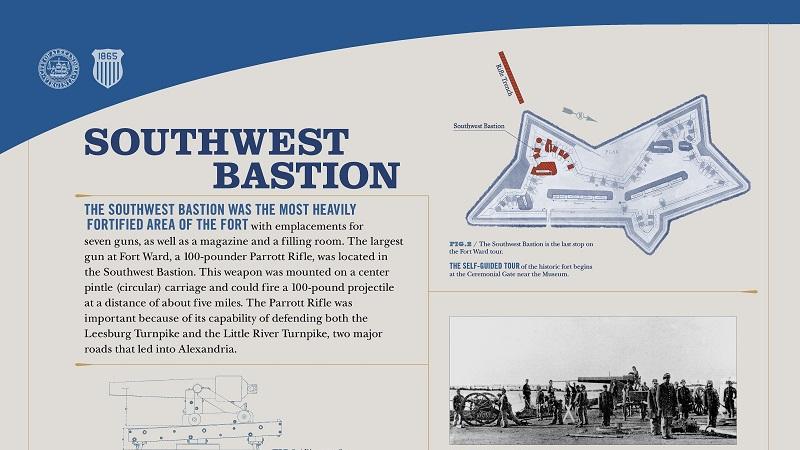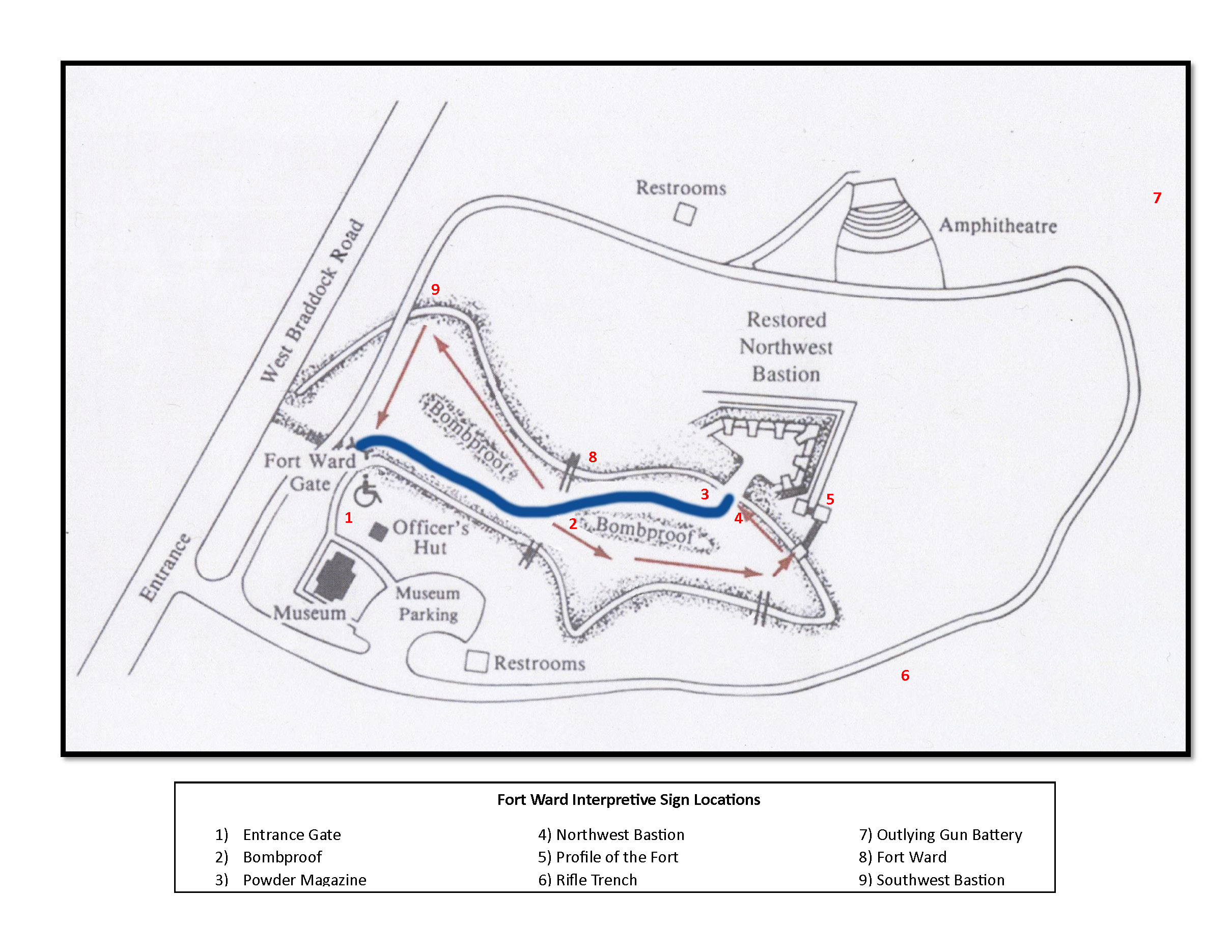
Tour the Museum and Historic Site Online
Tour Fort Ward

Outdoor Wayfinding Signage
Parts of the Fort
- East Bastion: This Bastion protected the rear wall of the fort from the Ceremonial Gate to the North Bastion. Jutting out from the earthen walls with four strategically placed guns, the East Bastion protected the entire area behind the fort where the officers’ quarters, barracks and mess hall were located.
- North Bastion: The North Bastion’s guns were positioned to cover one of the major routes into Alexandria (Leesburg Turnpike) as well as provide protection for an outlying rifle trench. The rifle trench extended from the point of the North Bastion to Battery Garesche, the next fort in line, about two miles away.
- Northwest Bastion: The Northwest Bastion, together with its counterpart the Southwest Bastion, were the major defensive elements of Fort Ward. Armed with two 24-pounder Howitzers, three 4.5" ordnance rifles and a six-pounder James rifle, the Northwest Bastion guarded the approach to Alexandria along the Leesburg Turnpike (State Route 7).
- South Bastion: Guns in the South Bastion were mounted to cover the ditch along the wall of the Southwest Bastion.
- Southwest Bastion: The largest gun in the fort, a 100-pounder Parrott rifle, was mounted en barbette on a center pintle carriage at the point of the Southwest Bastion. This weapon had a maximum range of five miles and the center pintle carriage enabled the gun to be aimed in any direction, providing a significant range of fire to guard the approach to Alexandria via Little River Turnpike (State Route 236).
- Rifle Trench: Rifle trenches were dug with earth piled to the exposed (defensive) side into which infantry could move without exposure to enemy fire. These trenches connected many of the forts in the Defenses of Washington to prevent an advancing enemy from executing a flanking maneuver to the rear of the forts.
- Abatis: An abatis was constructed from the branches of large trees piled several feet high in a line along the outer wall of the ditch (dry moat). The ends of the branches pointing outward were cut to a point to deter enemy troops from breaching the line. An abatis usually surrounded the entire perimeter of the fort, having the same effect as barbed wire.
- Bombproofs: These partially underground structures were located in the center of the fort. Designed to provide space for operations in the event a fort came under attack, the bombproof could hold one third of the fort’s complement of troops. Space was also allocated for a guard house and dispensary. Covered by several feet of earth, a breastheight and banquette were also constructed on top of the bombproof as a line of defense for infantry in any attempt to breach the fort’s walls.
- Powder Magazine and Filling Room: Ammunition for the fort’s guns was kept in underground storage facilities called powder magazines and filling rooms. Shells were armed and sometimes stored in the filling room, while the magazine was used to hold black powder and crated rounds. Implements for firing the cannons could also be kept in the filling room.
- Officers’ Quarters and Barracks: The garrison for a fort lived outside the earthen structure. The officers’ quarters, barracks and mess hall as well as other support buildings were located to the rear of the fort. In an attack, the troops would have moved inside the earthen structure, closing the gate.
- Ceremonial Gate: The large Ceremonial Gate was erected in 1865 to mark the main entrance to Fort Ward. The arch was adorned with a castle, the insignia of the U.S. Army Corps of Engineers, which designed and supervised the construction of the fort. The gate’s columns were topped with a stand of cannon balls in tribute to the artillerymen who manned the fort from 1861-1865. This gate, which marks the site of the original structure, has been reproduced from a Corps of Engineers drawing for Fort Ward.
Glossary of Military Terms
- Abatis (Ah-ba-tee): A barrier of felled trees with sharpened and entangled branches pointing toward the enemy and lined up in a mass along the glacis. The abatis served to impede the enemy advance upon the fort.
- Banquette (baun-kett): The narrow walk behind the breastheight or interior slope on which the infantry stands while firing. The flat walk is the banquette tread; the slope up to it is the banquette slope.
- Barbette: Raising a gun by placing it on a high carriage or mound of earth so that it fires over the parapet rather than through an opening in the wall, expanding its range of fire.
- Bastioned fort: A fortification plan which assures that every section of the fort is mutually supported by fire from another part. The star-shaped fort with five or more bastions is considered the ideal fort and is generally used only for important works.
- Breastheight or interior slope: The inside of the fort wall (parapet) where the defender leans while firing.
- Counterscarp: The outer slope of the ditch (dry moat), opposite the parapet.
- Ditch: A deep dry moat surrounding the fort in front of the parapet. It is designed to impede access to the parapet.
- Embrasure: An opening in the parapet (fort wall) through which a gun is fired. Although it weakens the parapet to assault, the embrasure provides protection for the gun crew.
- Emplacement: see Embrasure.
- Exterior slope: That part of the parapet facing toward the enemy.
- Filling room: An underground structure like a powder magazine where rounds were armed and loose powder, shot and firing implements were kept.
- Flanking maneuver: The movement of troops around an enemy or his works in an effort to get behind and cut off any possibility of escape. In a defensive system like the forts that surrounded Washington, D.C., rifle trenches and outlying gun batteries constructed between the forts all but eliminated the possibility of such a movement.
- Gabion (gay-bee-un): A round, wicker cylinder, approximately 24" in diameter and 3' high, filled with sod. Gabions were used to line gun embrasures and could be used for other purposes like supporting the walls of a temporary fortification.
- Garrison: The troops stationed at a fort or other military stronghold.
- Glacis (gla-see): The raised ground in front of the ditch, which exposes the enemy to the defenders' fire.
- Interior slope: see Breastheight.
- Ordnance: Military weapons, ammunition and equipment.
- Parade ground: The flat area in the center of the fort.
- Parapet: An elevated wall or embankment constructed from earth, wood or stone designed to intercept enemy fire.
- Powder magazine: An underground structure where containerized rounds and black powder for the ordnance of a fort were kept.
- Profile: A vertical cross-section of the fort.
- Revetment: Material such as blocks of sod, trunks of small trees (pole revetting), or horizontally placed boards used to support the earthen walls on the interior of a field fortification. Pole revetting was the preferred choice.
- Rifle trench: A deep ditch with excavated earth piled along the exposed side that protected infantry from enemy fire and enabled them to prevent a flanking maneuver on the fort or battery.
- Scarp: The inner slope of the ditch (or moat) that surrounds a fort; the same as the exterior slope.
- Superior slope: The top of the parapet.
- Trace: The ground-plan or outline of the fort.
- Terreplein (ter-a-plane): The flat ground inside the fort, at least 6'6" below the top of the parapet.
- Traverse: A breastheight placed on top of the magazine, bombproof or filling room to form a second line of defense, usually accessed by a ladder or steps.
Google 360 Virtual Tours
You can also visit the Fort on Google 360 Virtual Tours (2017).
Touring the Museum
Inside the Museum you will see many original Civil War period objects which curators and other staff care for, conserve and display. Among the objects on view are uniforms, diaries and letters belonging to Union soldiers, weapons and military equipment, surgeons’ tools, musical instruments, and photographs. These authentic objects and images are displayed in thematic exhibits on topics such as medical care, the artillery, and the common soldier.
Museum Exhibits
Thematic exhibitions explore different facets of Civil War military and civilian life, especially those related to the Defenses of Washington, the life of the Union soldier and local history focusing on wartime Alexandria.
The Common Soldier:
The typical Union foot-soldier carried with him all of the equipment necessary to fight and survive. In this exhibit, objects from the Museum’s permanent collection illustrate the daily life of the typical Union soldier. Among the equipment displayed are examples of Springfield and Enfield rifle-muskets, cartridge and cap boxes, a knapsack, mess utensils, and a variety of personal objects used for leisure-time activities. Of special interest is a protective vest called body armor.
The Art of the Artilleryman
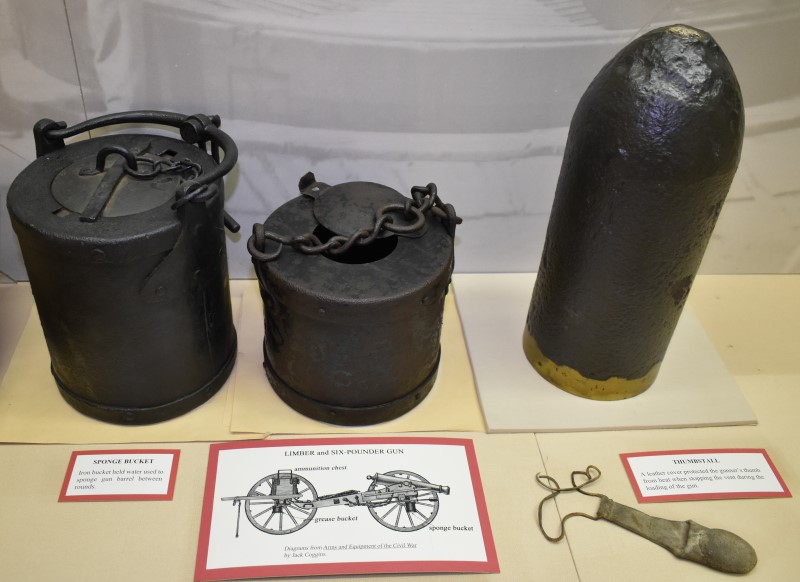
Many artillery regiments were stationed in the Defenses of Washington. A well-drilled artillery crew could fire a typical Civil War cannon two to three times a minute. In this exhibit, discover the tools and equipment used by artillerymen to aim, load and fire a cannon. Brochure available.
Medical Care for the Civil War Soldier
At the beginning of the Civil War, neither side was prepared to care for the vast numbers of sick and wounded. Three out of four Civil War soldiers died of disease rather than from battle wounds.
A broad selection of medical tools, equipment and images is featured, illustrating treatment practices of the time, the importance of the ambulance corps, the vital efforts of women such as Dorothea Dix and Clara Barton in nursing the troops, and the role of Alexandria as a major hospital center for the Union Army.
A number of surgical instruments are displayed, such as: a trephine used to drill into the skull, a surgeon’s amputation kit, a tourniquet, a tenaculum used to tie off arteries, suture needles, a forceps and scalpels. Several examples of medicine tins are included which held contents like chloroform for anesthesia, cholera mix for digestive illnesses, and quinine to relieve fevers and other ailments. Examples of small pocket surgical kits and a surgeon’s field case are included, as well as arm and leg splints and a crutch.
Images and information related to some of Alexandria’s Union Army hospitals are also on view, such as an original albumen photograph by Andrew J. Russell of the Mansion House Hospital, a period envelope with an engraving of the Lyceum Hospital on the cover, and photographs of other hospital facilities like the Fairfax Seminary and Wolfe Street Hospitals.
The exhibit is accompanied by a brochure on medical care for the Civil War soldier.
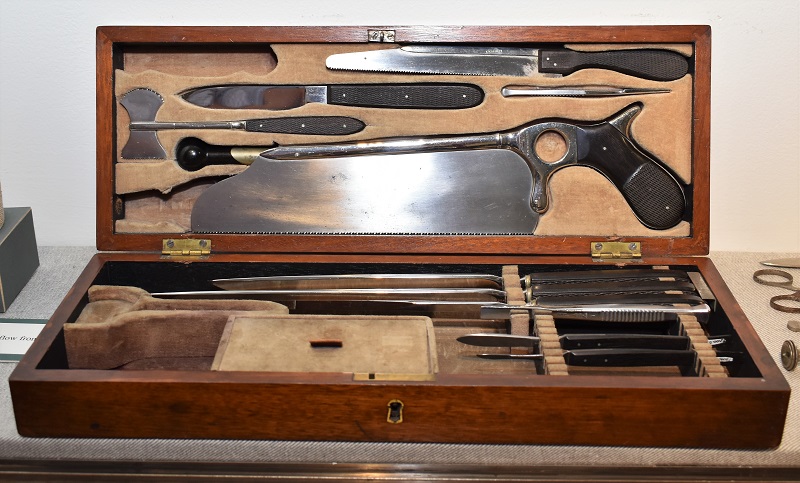
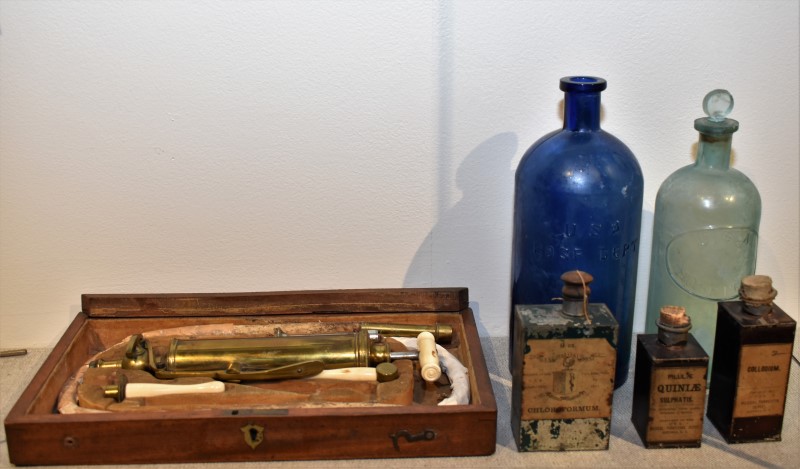
Lewis Cass White: Preserving the Legacy of Fort Stevens
May 25, 2024 to May 31, 2025
The exhibit, which explores the efforts of a Civil War veteran to preserve and recognize the site of Fort Stevens in the Defenses of Washington, is being held in 2024 in recognition of the 160th anniversary of the Battle of Fort Stevens.
Learn More
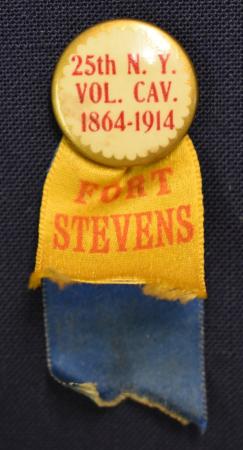
Tools of the Soldiers’ Trade
This display of firearms and related equipment used by the Civil War artilleryman traces the evolution of nineteenth-century firearms technology. From the obsolete smoothbore musket and the standard Springfield rifled musket, to Sharps Rifles and repeating carbines, Civil War soldiers were progressively equipped with more accurate, longer-range and more lethal guns. Improvements in firearm technology also meant that more specialized uses – such as firing while on horseback – could adapt small weapons to soldiers’ needs. Gun tools from the Fort Ward collection complement the firearms and show the everyday items Civil War soldiers used to clean and repair their weapons.
